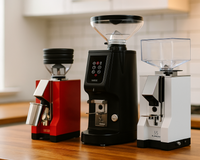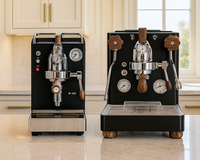When you wake up in the morning, chances are you’re craving coffee—not in 30 minutes, not in an hour, but right now. But if you’ve invested in a high-end espresso machine, you already know that instant coffee isn’t the goal. True espresso requires patience, and one of the most misunderstood aspects of this process is espresso machine warm-up time.
Many first-time buyers assume that as soon as the “power” light switches on, their machine is ready to pull a café-worthy shot. Unfortunately, that’s not the case. The truth is, warm-up time is one of the most important (and most overlooked) factors in brewing great espresso. If you cut corners here, your espresso suffers—thin crema, sour flavors, poor body, and inconsistent steam for milk drinks.
At Cliff & Pebble, where we specialize in high-end espresso machines and grinders, warm-up time is a frequent question we get from customers. Some want the fastest possible machine; others are happy to wait if it means flawless consistency. In this comprehensive guide, we’ll break down:
-
Why warm-up time matters for espresso quality
-
How long different types of machines actually take
-
The difference between boiler types and warm-up speed
-
Real-world strategies to shorten heat-up times
-
Which machines strike the best balance between speed and performance
And most importantly, we’ll highlight some of the best espresso machines available today—so you can find the right match for your lifestyle and patience level.
Why Espresso Machine Warm-Up Time Matters
Before we get into specific times, let’s answer the big question: why does it matter how long your espresso machine takes to warm up?
Espresso is a game of precision. Unlike drip coffee, where a few degrees here or there won’t ruin the brew, espresso is incredibly sensitive. You’re forcing hot water through finely ground coffee at high pressure, and even tiny variations can change the flavor profile.
Here’s what’s happening during warm-up:
-
Heating the Boiler(s): The water inside must reach and stabilize at a precise brewing temperature, usually around 190–205°F (88–96°C).
-
Saturating the Group Head: The group head (the part where the portafilter locks in) must absorb heat so that water stays stable when it makes contact with coffee. A cold group head will instantly cool water, leading to sour extractions.
-
Warming the Portafilter: If your portafilter is cold, it acts like an ice cube, stealing heat from the brewing process. Keeping it locked in during warm-up ensures proper temperature balance.
-
Building Steam Pressure: For cappuccinos and lattes, the steam boiler (or combined boiler system) must heat enough to produce dry, consistent steam for milk frothing.
In short: if your machine isn’t fully warmed up, you’re not getting the espresso you paid for.
How Long Do Espresso Machines Take to Warm Up?
This is one of the first questions new buyers ask us at Cliff & Pebble. The answer depends heavily on the type of machine you choose. Let’s break it down:
1. Single Boiler Machines – 5 to 10 Minutes
Single boilers are compact and efficient, heating up relatively quickly. They have one boiler that switches between brewing and steaming, so while they’re fast to heat, they do require some waiting when moving between espresso and milk-based drinks.
-
Example: Lelit Anna
-
Warm-up time: about 5–7 minutes
-
Best for: Beginners and small households who prioritize speed and simplicity over simultaneous brewing/steaming.
-
2. Heat Exchanger Machines – 15 to 20 Minutes
Heat exchangers (HX machines) are a step up, offering the ability to brew and steam at the same time. However, the popular E61 group head—a hallmark of HX machines—takes longer to heat fully. This means while the boiler may be hot in 10 minutes, the group head often needs closer to 20 minutes for stability.
-
Example: Lelit Mara X
-
Warm-up time: 15–20 minutes
-
Special feature: Smart temperature regulation makes this one of the fastest HX machines in its class.
-

3. Dual Boiler Machines – 20 to 30 Minutes
Dual boilers are the gold standard for consistency. With separate boilers for brewing and steaming, they’re the choice of serious home baristas. The trade-off is warm-up time: with more components to heat, patience is required.
-
Example: Lelit Bianca V3
-
Warm-up time: 25–30 minutes
-
Why it’s worth it: Unmatched control with flow profiling, stable extractions, and endless customization.
-

-
Example: Rocket Espresso R58 Cinquantotto
-
Warm-up time: around 25 minutes
-
Who it’s for: Those who want Italian craftsmanship and professional-grade stability.
-
4. Thermoblock Machines – 2 to 5 Minutes
Thermoblocks prioritize speed, heating water on demand as it passes through a heated block. They’re lightning fast but don’t offer the same temperature stability as boilers.
-
Example: Entry-level consumer machines (not typically sold by Cliff & Pebble since our focus is on long-term performance).
-
Warm-up time: practically instant
-
Best for: Speed-focused users who value convenience over café-level precision.
-
The Role of the E61 Group Head
It’s worth highlighting the E61 group head, found on many high-end machines like the Mara X and Bianca V3. The E61 is beloved for its thermal stability and durability—but it takes time to heat properly.
Even if the boiler reaches temperature quickly, the solid brass group head needs at least 15–20 minutes to fully saturate. This is why you’ll often see manufacturers recommend waiting longer than you expect.
Pro Tip: If you want to speed up the process, run a blank shot (hot water through the group head with no coffee). This brings the metal closer to operating temperature faster.
How to Speed Up Espresso Machine Warm-Up Times
Waiting 20–30 minutes every morning isn’t ideal—especially if you’re getting ready for work. Luckily, there are a few tricks that can make your espresso machine feel “instant-on.”
1. Use a Smart Plug or Outlet Timer
One of the simplest hacks: plug your espresso machine into a smart plug or outlet timer. Program it to turn on 20–30 minutes before you wake up, and your machine will be ready by the time you hit the kitchen.
2. Keep the Portafilter Locked In
Never leave your portafilter sitting on the counter. Keeping it locked in the group head ensures it warms up alongside the machine. This helps prevent temperature loss when brewing.
3. Flush the Group Head
Running hot water through the group head heats the metal faster. Do this once or twice during warm-up to shave minutes off the process.
4. Don’t Skimp on the Wait
Some manufacturers claim “ready to brew in 5 minutes.” While technically true (the boiler reaches temperature), the rest of the machine isn’t ready. Be patient—it’s worth it.
5. Insulate in Cold Environments
If your espresso machine sits in a cold kitchen or basement, consider a machine cover. Insulating the unit helps retain residual heat overnight, reducing warm-up time in the morning.
Warm-Up Time vs Lifestyle: Which Machine Fits You Best?
Choosing an espresso machine isn’t just about boilers and group heads—it’s about your lifestyle. Here’s how to decide:
-
For busy professionals: A single boiler like the Lelit Anna offers quick warm-up times, perfect for fast shots before work.
-
For balance seekers: The Lelit Mara X is the sweet spot—fast warm-up, E61 performance, and the ability to steam and brew at once.
-
For perfectionists: Machines like the Lelit Bianca V3 or Rocket R58 Cinquantotto take longer, but reward patience with café-quality espresso.
At Cliff & Pebble, we often recommend customers ask themselves: Would I rather have espresso in 5 minutes, or perfect espresso in 25 minutes? There’s no wrong answer—it’s about what matters most to you.
Frequently Asked Questions About Espresso Machine Warm-Up Times
Q: Can I pull a shot before my machine is fully warmed up?
Technically yes, but you’ll likely get under-extracted espresso with sour or thin flavors. For best results, wait until the group head and portafilter are fully heated.
Q: Do dual boilers always take longer than single boilers?
Generally yes, since they’re heating two systems at once. However, some modern dual boilers are designed with faster heat-up elements.
Q: Does leaving my machine on all day damage it?
Not necessarily. Many baristas leave their machines on for long periods. However, it can shorten the lifespan of gaskets and seals. A smart plug helps balance convenience and longevity.
Q: Why does my manual say “ready in 10 minutes,” but my shots taste better after 25?
Because the boiler heats quickly, but the rest of the machine (group head, portafilter, internal components) takes longer to reach stability.
Cliff & Pebble’s Top Picks for Warm-Up Performance
To make it easy, here are our best espresso machines ranked by warm-up speed and quality balance:
-
Fastest Starter: Lelit Anna – Single boiler, quick heat-up, beginner friendly.
-
Best Balance: Lelit Mara X – HX machine with smart warm-up technology.
-
Ultimate Control: Lelit Bianca V3 – Dual boiler with flow control and unmatched consistency.
-
Italian Luxury: Rocket R58 Cinquantotto – Longer warm-up, but true café performance.
Final Thoughts: Patience Pays Off
Espresso is as much about ritual as it is about caffeine. While warm-up times can feel frustrating, they’re actually the key to unlocking the full potential of your machine.
At Cliff & Pebble, we believe that the difference between “good” and “extraordinary” espresso often comes down to patience. Whether you want a fast, reliable single boiler or a dual boiler built for perfectionists, we’re here to help you find the right fit.
Ready to upgrade? Explore our full collection of espresso machines today and discover why proper warm-up time makes all the difference.















